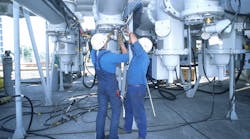5 Tips for Transitioning from a Maintenance Paper Trail to a CMMS
Making the switch to a computerized maintenance management system (CMMS) can be overwhelming for manufacturers that are still using paper and excel spreadsheets. Also, those with an aging workforce who are not tech-savvy may be apprehensive.
Gearing up for the change requires a plan. Without one, you're likely to waste time and energy, and not accrue all of the hoped-for gains. Getting the system set up and using it correctly, however, will streamline work order management, reduce energy expenses and protect technology -- helping your operations run at peak efficiency. You'll quickly come to appreciate gaining better control over processes and real-time access to critical reporting metrics.
One of the biggest implementation challenges is committing the time and resources to the implementation and not getting derailed by the day-to-day crises that inevitably pop up. Making an investment and dedicating a part of each day to it for up to four to six weeks will help ensure a strong implementation and help generate reliable initial results.
Here are a few key considerations to help ease the transition.
1) The Implementation Team
For a paper to online CMMS implementation, it is important to ensure there is a small team (two to three people) dedicated to oversee the transition process. Designating a lead planner and scheduler, typically the maintenance manager, supervisor or operations executive, helps ensure consistency in the way that data are collected and entered. It also is helpful to streamlining the way processes are defined. These include processes such as how to route and distribute work orders once generated, what work order or equipment data to collect and input into the system, or what the review process is before closing a work order.
Defining the information that is important to the organization helps ensure the right data are collected accurately and efficiently. The implementation team should have a solid understanding of how the business processes manufacturing and maintenance information, how it organizes workflows and analyzes key maintenance data like downtime, and reasons for equipment failures.
2) The Data
A CMMS relies on having the appropriate and detailed data on your equipment and inventory and entering that into the system. This type of information most often resides in spreadsheets or related production systems. Determine how accessible the data are and a reasonable baseline of how much to collect before making the transition.
The key is to be realistic. Perfect and complete data are not realistic, but take time to define equipment hierarchies at a high-level perspective. While the machine center architecture is essential to getting started, component level information can be added later as the system is utilized. Collect equipment boilerplate or nameplate info but don’t stress over every detail attribute -- they aren’t critical for the kick off phase. Also, mobile devices can help the team complete this detail once the solution is in use.
3) The Resources
It is important to consider the technology capabilities of the team that will be required to use the CMMS. How comfortable are they using technology, logging onto a tablet or PC, and utilizing a browser to access info? Because of technology’s pervasiveness today, there aren’t often any adoption restrictions or barriers for technicians that are early in their careers.
However, don’t forget to consider your knowledge-rich resources who may not have any hands-on PC or tablet experience and need an introduction to the technology basics. Offering technology training -- whether that is “Computers 101” through your training department or hands-on training with your technology-savvy team members -- will help ease their comfort level and their commitment to embracing the system.
4) The Training
As consistency is helpful to data quality and ultimately reporting, the entire maintenance team should be trained on the CMMS best practices and functionality. In addition, the implementation team should also consider what type of instructions and/or step-by-step guides they should provide at work stations for easing use of the new system. This is especially important at the technician and requestor level.
Once the application is implemented and baseline organizational data is available, take screenshots to illustrate how to use the system. This might include graphical instructions of how to fill in a work order, how to record labor, how to issue a part or how to select the proper failure code. Developing this once the system is initially populated with organizational data will help provide reassurance to those who are still getting comfortable with technology and will help ensure recording uniformity.
5) The Codification
One of the key benefits of moving to a CMMS is being able to utilize industry standard equipment and maintenance codes to track performance and trends with an eye for preventive maintenance. Start with a manageable number of codes; we recommend 10 to 15 industry-standard codes that can be augmented and customized as the system is further utilized. For example, standard failure codes may include Accidental Damage, Misalignment, Improper Installation, Inadequate Design, etc.
Most maintenance managers and supervisors know the common problems encountered and how to navigate the resolution of those problems. Leverage that knowledge in the CMMS and label corrective and breakdown maintenance activities. Consistent problem and failure codes can provide valuable information when evaluating equipment failure and prioritizing corrective measures.
The End Game Takeaways
Managing equipment uptime and reliability in the manufacturing environment is no easy task given aggressive production schedules, limited maintenance budgets and scarce resources. An efficient CMMS implementation -- one that doesn’t let perfect be the enemy of good -- will help streamline maintenance operations so that thorough information is collected and work can be completed efficiently. This will help simplify planned maintenance scheduling, extend the life of equipment and enable more data driven decision-making to maximize plant productivity.
A manufacturing thought leader with more than 20 years of experience in the asset management software industry, Dwayne Divers is Dude Solutions' director of manufacturing strategy. He has held senior positions at Datastream (now Infor), Yardstick Software and Milliken, among others and earned a Bachelor of Science degree in chemical engineering from Virginia Tech.




